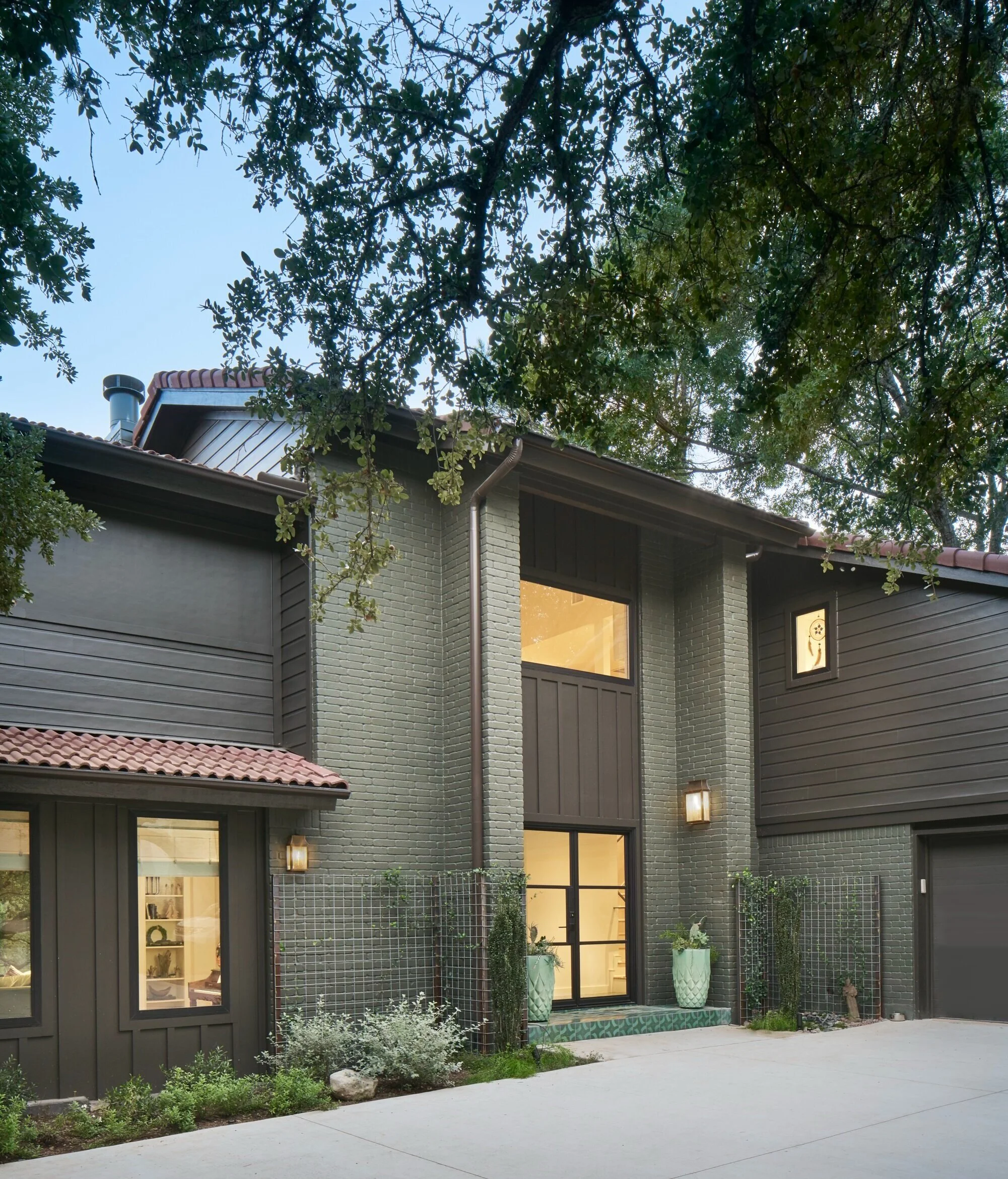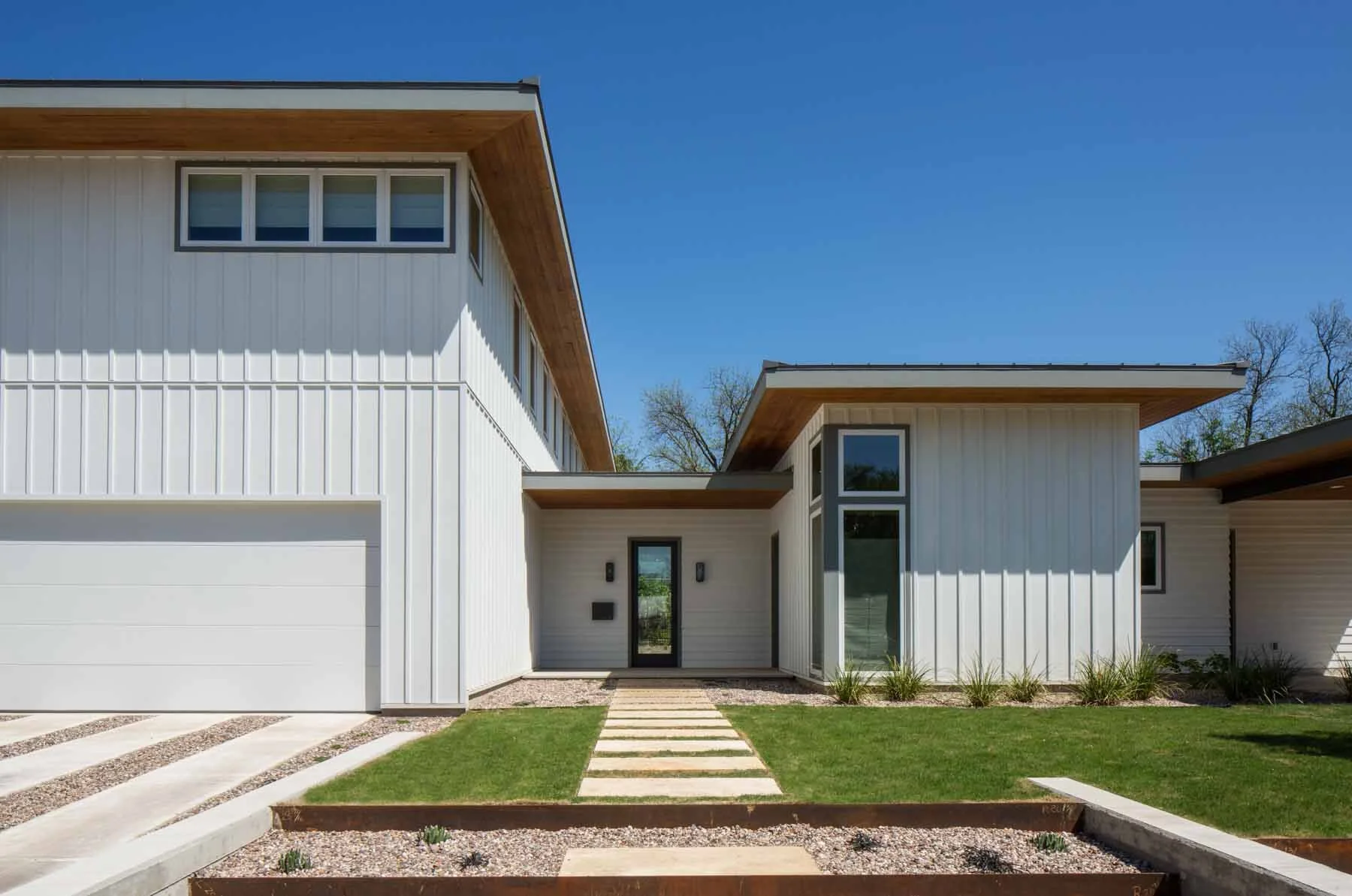The Best Roofing Materials for Pitched and Flat Roofs
One of the most important features of your home is the roof. The roof design and roofing material selections are not only important in regards to matching the overall home aesthetic, but they are also necessary to protect the home from wind, water, and outdoor elements. Pitched and flat roofs can create different moods and styles, and they both require different types of roofing materials to make sure they are sealed and properly functional. Our Austin, Texas architects are explaining the main roof types as well as the best roofing materials to apply to a pitched or flat roof.
Types of Roofing Materials for Pitched Roofs
A pitched roof is a roof that slopes downward either from a central ridge or from one edge to another. They can have different slopes and range from steep to almost flat. Some common types include gable, which forms a triangular shape, and hip, which slopes on all four sides. Pitched roofs are typically more commonly seen in residential and traditional styled architecture. There are six popular roofing material selections for pitched roofs.
Asphalt Shingles
Asphalt shingles are the most common roofing material in the United States because they are economical, easy to install, simple to maintain, and can last up to 20 or 30 years. This roofing material is made from a fiberglass base and is topped with asphalt and mineral granules. There are many color options available, and this style of roof can be applied to numerous home designs.
Metal Panels
Metal roofing is becoming an increasingly popular material because of its durability, easy upkeep, and resistance to extreme weather, fire, and snow. This lightweight material is available in aluminum, copper, stainless steel, and zinc as well as many color options. This material could be utilized on modern, rustic, or beach styled homes. Some metal roofs have been known to last over 75 years, and many can be recycled when it is time to replace.
Palo Pinto
Clay or Concrete Tiles
Clay and concrete tiles have similar aesthetics and benefits. They are molded into interlocking shapes, extremely heavy, wind resistance, and colored to meet a wide range of styles. These materials typically are seen in desert or coastal style homes. Clay tiles can be expensive and time-consuming to install, but they can last more than a century if well maintained. Concrete tiles typically cost around one-third less than clay, but they have a shorter lifespan of around 50 years.
Bend of the River remodel
Wood Shingles
Wood shingles are beautiful, charming, and picturesque. Wood shingles are typically made from cedar and can be seen on cape cod bungalows and luxury estates. This roofing material can be expensive, and it also has a large set of limitations. Wood roofing is not recommended for climates that get a lot of moisture or areas that are at high risk for wildfires. They also require a lot of maintenance. The lifespan of this roof can last from 20 to 60 years, depending on the climate and upkeep.
Slate Shingles
Slate shingles are extremely elegant, heavy, and expensive. This traditional roofing material has been used for hundreds of years and has been known to last for hundreds of years as well. Slate shingles are made from natural stone, and they are ideal for roofing because slate tends to split in thin sheets when quarried. Installing a slate roof requires a specialized expert and artisan of the craft.
Synthetic Shingles
Synthetic shingles are made to emulate slate, but they are made from engineered polymers, recycled plastic, and rubber. Visually, they are a convincing copy of the real thing. They come with the added benefit of reduced cost and weight, making it a good material for roofs that can’t support heavy stone or tile. The lifespan of synthetic shingles is less than stone, but they can last up to 50 years.
Types of Roofing Materials for Flat or Low Pitched Roofs
Flat or low pitched roofs are almost level rather than having a drastic slope. A slight slope will exist for proper water drainage and their pitch is typically around ten degrees. Flat roofs can create a modern feel, however, they have been used in architecture since ancient times. They are perfect for dry climates and for creating additional living spaces, like rooftop decks. Some people worry about flat roofs leaking, but there is no need to fret if you are selecting the proper roofing materials. Here are four common types of roofing selections for flat and low pitched roofs.
West 55th Addition
Built-Up or BUR Roofing
A built-up or BUR roof is one of the oldest types of roofing options for flat roofs, dating back over 100 years. This roof type is made from three or more layers of waterproof material (like roof felt, tar paper, or fiberglass membranes), hot tar, and river stone or gravel to finish it off. It is resistant to leaks and offers more protection than asphalt shingles. However, these roofs can become extremely heavy and the structure must be designed or modified to support them. BUR roofing lasts 15 to 20 years when properly maintained.
Modified Bitumen Roofing
Modified bitumen roofing was developed in the 1960s and uses the technology of BUR but adds a polymer reinforced roof wear layer or cap sheet. They can be applied with different methods like heat, torch, cold, or self-adhered. This roof style offers 5 layers of protection and can last up to 20 years.
Membrane Roofing
Membrane roofing is one of the latest developments for flat roofs, and it is commonly seen in commercial applications. It comes in a few varieties, but EPDM, or synthetic rubber, is the most popular. This material is applied as thin sheets, which makes it easy to install but also susceptible to punctures. They can last up to 25 years.
Rolled Roofing
Rolled roofing is one of the most popular options for residential flat and low slope roofs. These long sheets of asphalt are engrained with minerals, similar to asphalt shingles. This material can be applied with the torch method or roofing nails. While it is efficient, the appearance is often not ideal and the lifespan only lasts up to 10 years.
Woodview Residence
Do you need help selecting roofing materials or designing the perfect home?




